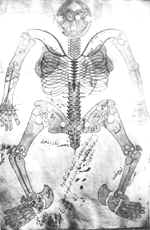|
|
According to "Stele of Hamurabi", on which most ancient written laws of mankind are recorded, origin of medicine may be traced back to years, even centuries, before second millennium B.C. 282 articles listed on Stele include several dealing with medicine. Among these, No. 215 infers that, about 2000 years before Christ, surgical bronze instruments were currently used in Mesopotamia, and that surgeons living 4000 years ago were able to perform refined operations, particularly in ophthalmologic field.
Text reads thus: "If a doctor heals a wound with a bronze instrument, removing the white stain of eye with it, he will receive 10 Silver Sokel for his medical fee."
In the face of this privilege, a strict code of medical ethics was also implemented. Thus, could see in Article 218: "If a doctor doesn't heal a wound and worsens the sick eye, both his hands should be severed."
In ancient Iran, medicine was based on more comprehensive laws, to which allusions are found in "Vandidad", collection of laws in "Mazd Yasna". Vandidad is written in the form of dialog and following teachings of "Ahura Mazda" recorded in this book.
The first physician capable of healing pain, fever and untimely death, in ancient world, was "Tariteh".
Paragraphs 36 and 37 of chapter 7 (Vandidad) describe arduous process of achieving title of physician. The book also refers to punition of an unskilled doctor, who touches upon surgery.
"Dinkert", whose text was most probably compiled from Sassanid sources, provides further information on medical science. It lists five means of healing:
1- Holy Word
2- Fire
3- Herbs
4- Knife
5- Cauterization
City of Jondishapour, built upon the order of "Shapour 1", was the medical center in Sassanid period. Here, a medical school and a hospital with its own school existed, which were distinctive of the city, assuring its re-known at least until 876 A.D.
Today, Hallmark of city is mausoleum of Iran's illustrious general, Safarid "Yaqoub Leis".
In the course of time, with gradual attraction of physicians from Jondishapour, by Caliphs, seated in Baqdad, scientific focus shifted from Jondishapour to Baqdad.
Nevertheless, thanks to Dailamite "Azedoddoleh", medical science once again flourished in Iran. In Shiraz, city's public hospital, known as "Azodi Hospital", was built as part of a university, where philosophy, astronomy, medicine, chemistry and mathematics were taught. Also, existence of scientists, such as Razi and Avicenna, as well as masters like Jorjani (compiler of "Zechariah Kharazmshahi Medical Encyclopedia"), permitted medical science to continue its evolution and have its Sassanid flourish again.
Following that radiant era, a period of despoilment came to pass, during which no scientific centrality existed.
Later, with accession of Qazan Khan, assisted by his minister, Rashideddin, physician of Abaqa Khan, a university town was erected in Iranian Capital. In view of establishing its medical school (Rashidi Darosshafa), fifty re-known physicians from India, China, Syria,... were brought together, each being entrusted education of ten students.
The enlightened minister also established another hospital in Soltanieh, in a district named after him. The expense of this hospital were provided by endowments. Moreover, yet another hospital, which served for many years, was created in Citadel of Soltanieh upon the orders of Sultan Mohammad Khoda Bandeh.

|
|

